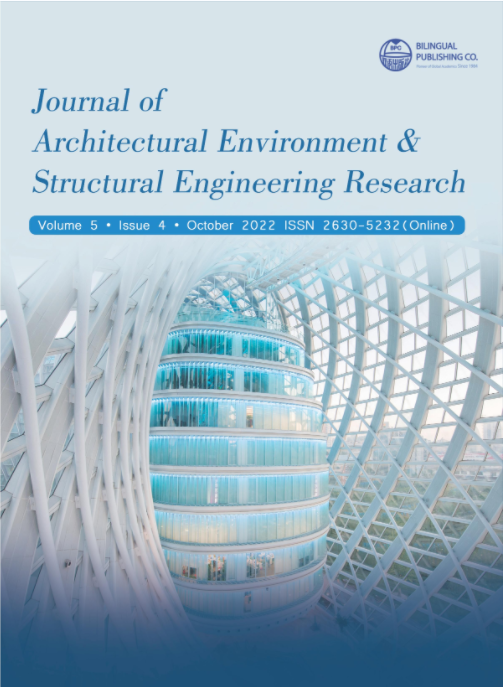-
2124
-
1859
-
1634
-
1570
-
1526
Failure Evaluation of Reinforced Concrete Beams Using Damage Mechanics and Classical Laminate Theory
DOI:
https://doi.org/10.30564/jaeser.v5i4.5028Abstract
The prediction of the behavior of reinforced concrete beams under bending is essential for the perfect design of these elements. Usually, the classical models do not incorporate the physical nonlinear behavior of concrete under tension and compression, which can underestimate the deformations in the structural element under short and long-term loads. In the present work, a variational formulation based on the Finite Element Method is presented to predict the flexural behavior of reinforced concrete beams. The physical nonlinearity due cracking of concrete is considered by utilization of damage concept in the definition of constitutive models, and the lamination theory it is used in discretization of section cross of beams. In the layered approach, the reinforced concrete element is formulated as a laminated composite that consists of thin layers, of concrete or steel that has been modeled as elasticperfectly plastic material. The comparison of numerical load-displacement results with experimental results found in the literature demonstrates a good approximation of the model and validates the application of the damage model in the Classical Laminate Theory to predict mechanical failure of reinforced concrete beam. The results obtained by the numerical model indicated a variation in the stress–strain behavior of each beam, while for under-reinforced beams, the compressive stresses did not reach the peak stress but the stress–strain behavior was observed in the nonlinear regime at failure, for the other beams, the concrete had reached its ultimate strain, and the beam’s neutral axis was close to the centroid of the cross-section.
Keywords:
Reinforced concrete, Damage mechanics, Finite Element Method, Laminate theoryReferences
[1] Wang, T., Hsu, T., 2001. Nonlinear finite element analysis of concrete structures using new constitutive models. Computer& Structures. 79, 2781-2791.
[2] Assan, A., 2002. Nonlinear analysis of reinforced concrete cylindrical shells. Computer&Structures. 80, 2177-2184.
[3] Tao, X., Phillips, D., 2005. A simplified isotropic damage model for concrete under bi-axial stress states. Cement & Concrete Composites. 27, 716-726.
[4] Mazars, J., Kotronis, P., Ragueneau, F., et al., 2006. Using multifiber beams to account for shear and torsion. Applications to concrete structural elements. Computer Methods in Applied Mechanics and Engineering. 195, 7264-7281.
[5] Butean, C., Heghes, B., 2020. Flexure Behavior of a two layer reinforced concrete beam. Procedia Manufacturing. 46, 110-115.
[6] Liu, C., Yang, Y., Wang, J., et al., 2020. Biaxial reinforced concrete constitutive models for implicit and explicit solvers with reduced mesh sensitivity. Engineering Structures. 219, 110880.
[7] Tjitradi, D., Eliatun, E., Taufik, S., 2017. 3D ANSYS numerical modeling of reinforced concrete beam behavior under different collapsed mechanisms. International Journal of Mechanics and Applications. 7(1), 14-23.
[8] Gorgogianni, A., Elias, J., Le, J.L., 2020. Mechanism-based energy regularization in computational modeling of quasibrittle fracture. Journal of Applied Mechanics. 87(9), 091003.
[9] Arruda, M.R.T., Pacheco, J., Castro, L.M.S., et al., 2022. A modified mazars damage model with energy regularization. Engineering Fracture Mechanics. 259, 108129.
[10] Carrera, E., Augello, R., Pagani, A., et al., 2021. Component-wise approach to reinforced concrete structures. Mechanics of Advanced Materials and Structures. 1-19.
[11] Arruda, M.R.T., Castro, L.M.S., 2021. Non-linear dynamic analysis of reinforced concrete structures with hybrid mixed stress finite elements. Advances Engineering Software. 153, 102965.
[12] Leone, F.A., Justusson, B.P., 2020. Effects of characteristic element length on fracture energy dissipation in continuum damage mechanics models. Journal of Composites Materials. 55(24), 3551-3566.
[13] Di Prisco, M., Mazars, J., 1996. Crush-crack’: a non-local damage model for concrete. Mechanics of Cohesive-frictional Materials. An International Journal on Experiments, Modelling and Computation of Materials and Structures. 1(4), 321-347. DOI: https://doi.org/10.1002/(SICI)1099-1484 (199610)1:43.0.CO;2-2
[14] Mazars, J., Lemaitre, J., 1985. Application of Continuous Damage Mechanics to Strain and Fracture Behavior of Concrete. Shah, S.P. (eds) Application of Fracture Mechanics to Cementitious Composites. NATO ASI Series, vol 94. Springer, Dordrecht. DOI: https://doi.org/10.1007/978-94-009-5121-1_17
[15] Alva, G.M.S., El Debs, A.L.H.C., Kaminski Jr, J., 2010. Nonlinear analysis of reinforced concrete structures in design procedures: application of lumped dissipation models. Revista IBRACON de Estruturas e Materiais. 3, 149-178. DOI: https://doi.org/10.1590/S1983-41952010000200003
[16] Reddy, J.N., 2004. Mechanics of laminated composite plates and shells: theory and analysis. CRC Press. USA. pp. 831.
[17] Cook, R.D., Malkus, D.S., Plesha, M.E., et al., 2002. Concepts and applications of finite element analysis. John Wiley & Sons. Inc. USA. pp. 719.
[18] Martins, M.P., Rangel, C.S., Amario, M., et al., 2020. Modelling of tension stiffening effect in reinforced recycled concrete. Revista Ibracon de Estruturas e Materiais. 13, 1-21.




 José Mário Feitosa Lima
José Mário Feitosa Lima





